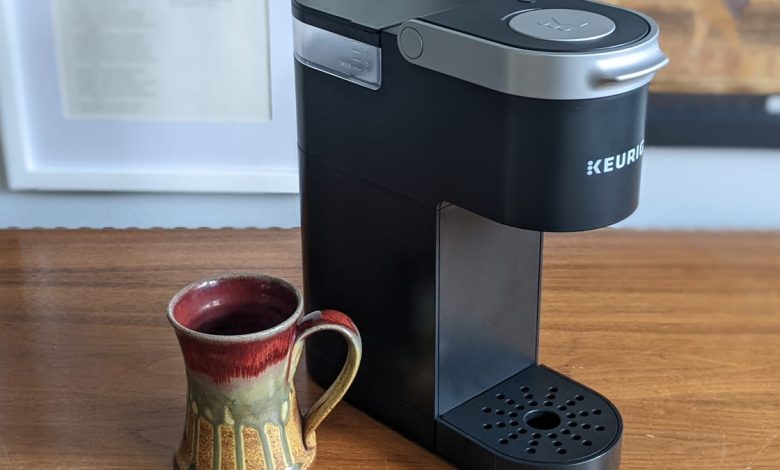Don’t Let Your Keurig Grow Mold. Here’s How You Should Really Be Cleaning It

Your Keurig takes care of your morning caffeine needs, but when was the last time you took care of your Keurig? If you’re not deep cleaning it once a week, chances are it’s pretty gross right now. Don’t worry though: we’ll show you how to clean it in no time.

If you leave your Keurig dirty long enough, it can affect the performance of your coffee machine as well as the taste of your coffee. Worse, when left dirty, it’s an ideal breeding ground for mold and bacteria. Fortunately, it’s pretty easy to give every inch of your Keurig the attention it deserves.
We’ve broken down everything you need to know about cleaning all parts of your Keurig coffee maker, from cleaning the drip trays to the brewing mechanisms and even the outside of your machine. For more, here they are our picks for the best coffee makers of 2024 and what to know about Keurig’s new compostable coffee pods.
Do not let the coffee capsules sit for days
One of the best things you can do for your Keurig is to treat it with care when you use it, especially if you use it every day. For example, remove used coffee capsules after they have cooled and try to take care of any spills or drips immediately. Coffee can go moldy after it’s brewed, and you don’t want it sitting in your Keurig holder.
Wipe down the outside of your Keurig
You can start the Keurig cleaning process by gently wiping the exterior of your coffee maker with a warm, damp cloth or paper towel. Not only does it Keurig I recommend daily coffee pot wipe, this is a really easy step to integrate into your daily cleaning routine. Just make sure your coffee pot is completely turned off and unplugged before you start cleaning.
Wash the drain pan
Keurig also recommends washing your drip tray daily, which catches drips from your coffee maker and spills. The drip tray is also prone to unsightly coffee stains. You can hand wash your drip tray with a little warm water and dish soap.
Take the water tank and the appropriate cover
Again, Keurig recommends cleaning this element of your coffee maker daily. Like the drip tray, you can deal with this by hand washing the water tank and the corresponding lid with warm water and dish soap. Depending on your coffee machine, you can wash both the tank and the lid in the dishwasher. Just remember to remove any water filters if you have any in your water tank.
Plus, fresh cold water in your Keurig every day tastes much better than water that’s been aged for days.
Wash the coffee pot and basket
If you have a K-Duo coffee pot, it means you have one extra step when it comes to daily care. You will need to wash the coffee pot and basket if you made a traditional cup of coffee. Like the water tank, you can wash the carafe and basket by hand or, depending on your coffee machine, you can put them in the dishwasher.
Clean the capsule holder
The pod holder can be one of the roughest parts of your Keurig machine. This is the tool that holds your coffee pod and can collect the used coffee grounds. If not cleaned somewhat regularly, it can get very gross very quickly and can also grow mold. Keurig advises cleaning this tool weekly, but we suggest wiping it down daily if it looks rough.
The Capsule Holder Assembly (PHA) will need to be removed from the Keurig before it can be cleaned. You can do this by grabbing the edge of the module and gently pulling it out. You will also need to separate the capsule holder from the attached funnel by pulling the two pieces apart. Be careful with the sharp exit needles when cleaning these parts.
Keurig advises rinsing with water, but it won’t hurt to scrub off any obviously rough spots or stuck-on coffee grounds—especially if this is the first time you’ve cleaned it.
Rinse your Keurig completely
To keep your Keurig running smoothly for as long as possible, you’ll want to do a regular cleaning brew, or a process called descaling. Essentially, descaling is a process of removing build-up. If you don’t regularly clean your Keurig’s brew mechanisms (Keurig officially recommends that you do this quarterly), build-up in your brew mechanism can start to affect the taste of your coffee.
The first step you will need to take is to run hot water through your coffee maker. You can do this by running your Keurig like you would if you were making a cup of coffee, but without a coffee pod.
You then have two options. You can either descale your coffee maker with a mixture of one part vinegar and one part water, or you can use Keurig’s proprietary descaling solution. Pour your chosen descaling solution into the reservoir and run your Keurig as usual. Once the machine is ready, you’ll want to let it rest for about 45 minutes.
We recommend running plain water through your Keurig a few times after descaling your machine to combat the vinegar taste. The last thing you want after spending so much time cleaning your Keurig is spoiled coffee.
For more cleaning tips, here’s how to a natural, all-purpose cleaner with three ingredients and how to quickly clean your kitchen in less than 15 minutes.




